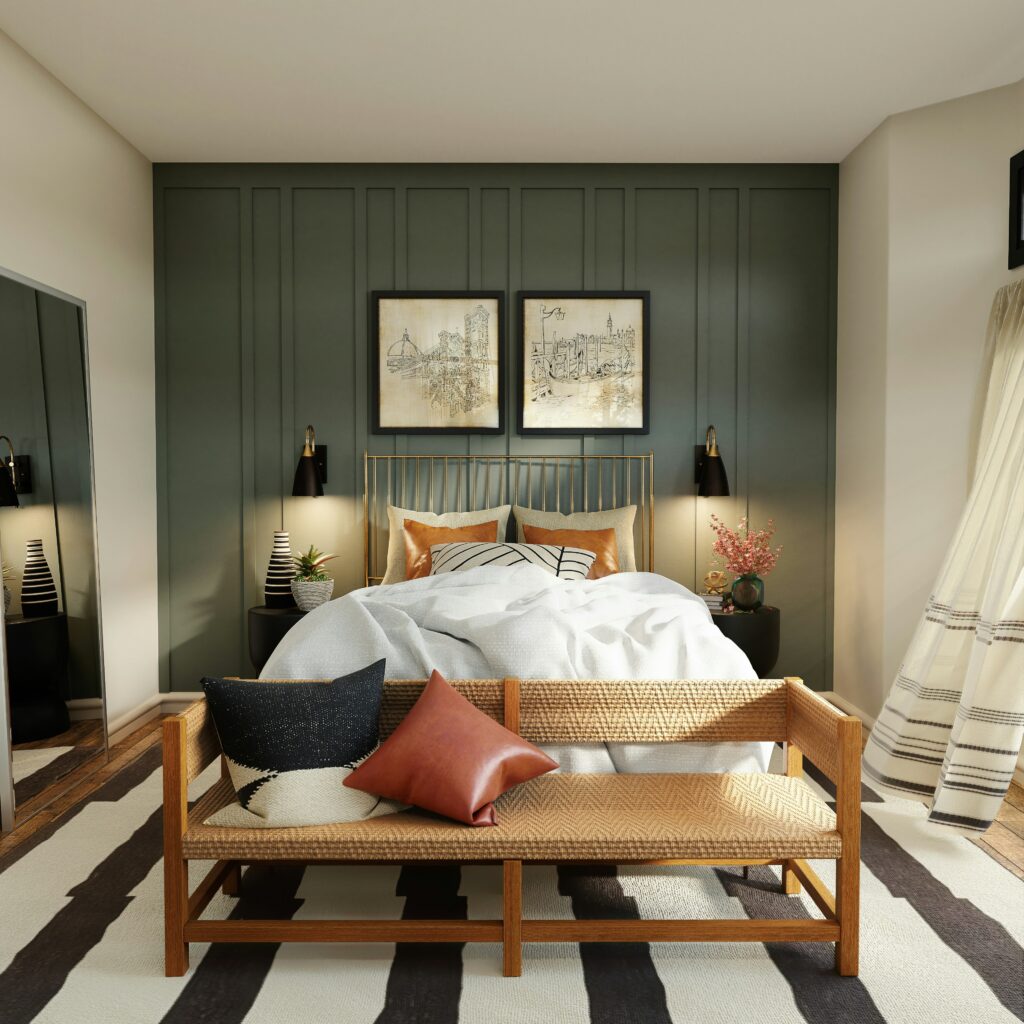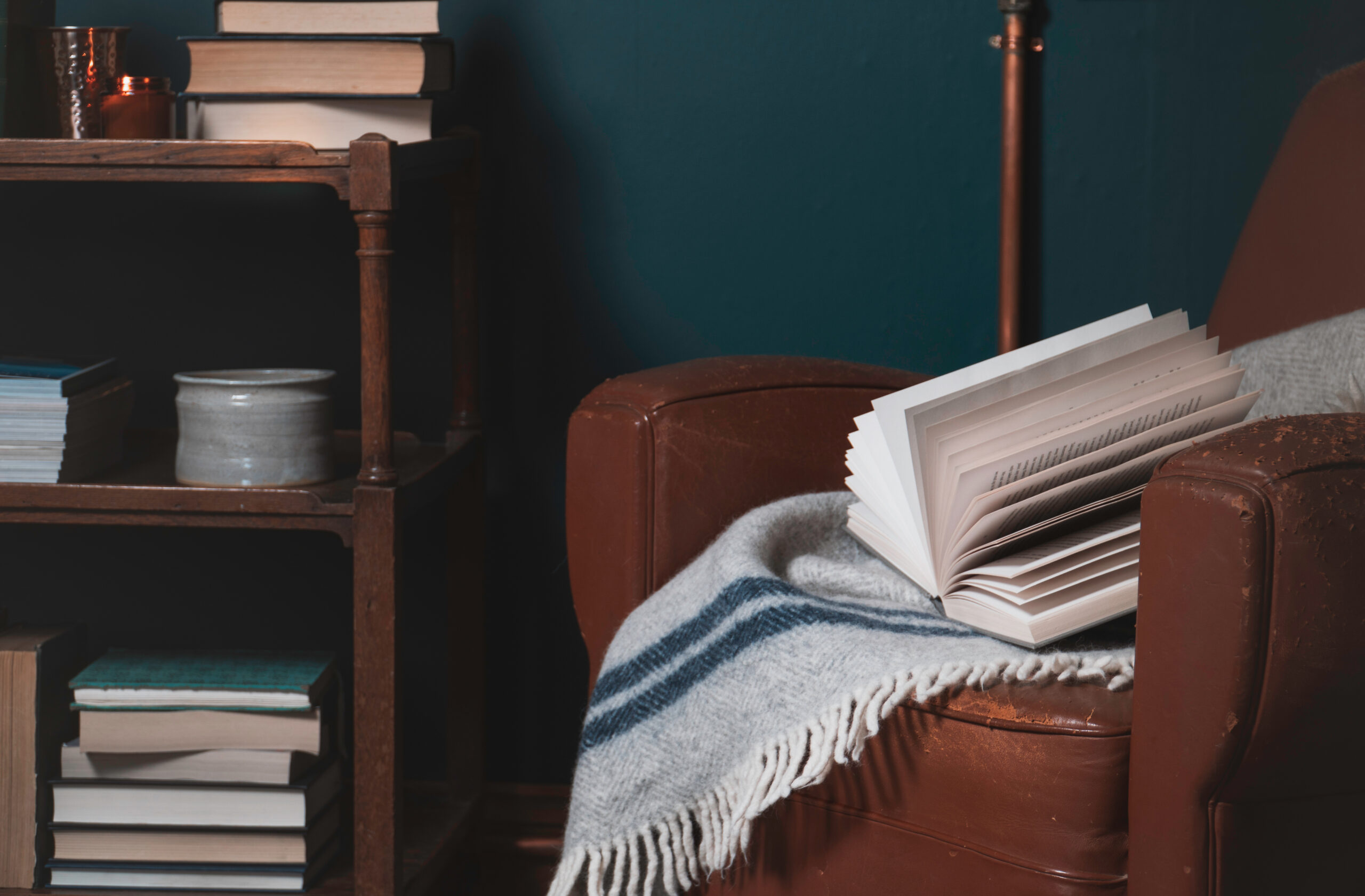Finding decorating tips for small spaces that don’t recommend costly changes can be challenging. I’ve been there. When we moved into this 900-square-foot cottage, not only did we move almost all the stuff we had in our last large apartment, but we also took ownership of furniture and other pieces that we shipped from my childhood home in Ohio after my parents died. Like you, I was puzzled about creating a cohesive design for our small spaces. Here are some decorating tips for small spaces that helped me start to deal with the suddenly packed cottage.
Resist Pushing All Your Big Furniture Pieces Against the Walls
Unless you have no option, try to resist the urge to place all your large furniture pieces against the walls. This is one of those decorating tips for small spaces that feels counterintuitive, but pushing couches, chairs, and desks against the walls may actually make your room feel smaller. Obviously, if you live in a very narrow “shotgun” style home, you may have to in order to allow people to walk through the space. However, in most cases, pulling your pieces away from the wall, even by a few inches, will make the room feel warmer and intimate rather than tiny.

Choose the Right Rug Size
Your impulse may be to select a rug significantly smaller than your room’s dimensions. One of my favorite decorating tips for small spaces is actually to go larger and let your furniture be your guide. Having your big living room furniture pieces, like the couch, entirely on or “front legs” on the rug will allow the rug to be a beautiful focal point for the room. Visually, the more expansive rug will draw the eyes. However, you do want to take care not to choose a rug so large that it feels like you just laid down wall-to-wall carpet. Surprisingly, If you choose a small rug that only sits under the coffee table, it’s likely to make your living room feel smaller because the rug’s dimensions are so small.
If you are trying to choose a rug for a small bedroom, use the bed as your focal point. The rug should be a way to highlight and pull the colors of the room together. You will want your bed’s legs to be entirely on the rug if possible. If you have a full bed, consider a 6-by-9-foot rug or go slightly larger. A queen bed, if the room allows for it, should be at least 8-by-10-foot. Ideally, you want at least 3 feet of rug around the sides and end of the bed for walking. If that’s not possible in your bedroom, pull the rug away from the wall so the headboard and legs are on the wood floor, and the rug extends beyond the sides and the end of the bed.
Balance Dark, Heavy Furniture with Lighter Options
I love solid wood furniture. We have vintage pieces that we love. In fact, I still have too many vintage pieces, but that’s a story for a different day. If you have a very small bedroom, filling it with giant, ornate, solid wood pieces will make the room feel tiny. If you love those pieces, I will never suggest decorating tips that would take that away from you. But if you have some wiggle room, try to balance larger, heavier-feeling pieces with ones that allow light to flow through them.
Do you have an armoire that you love? Great! One of my decorating tips for small spaces is to balance a large armoire with mirrors to bounce sunlight, delicate metallic lighting (rather than heavy sconces), and leggier side chairs (rather than solid club chairs). The same is true for living rooms. Choose a glass tabletop for your coffee table, declutter any open shelving, consider a spindle chair (Stickley-inspired looks, but without the price tag), and mix design periods. We have a dark wood fainting couch from the early 1930s that pairs beautifully with a Mid-Century Modern-inspired arc floor lamp.

Focus on Decorating Vertical Space
Towering headboards are also one of my favorite decorating tips for small spaces. They not only draw the eye up and make the room’s ceilings feel taller, but they can also dramatically impact the room’s vibe, depending on their style or fabric colors. I love headboards that also have storage. That’s particularly helpful if your bedroom is tiny and squeezing in nightstands isn’t ideal.
Tall, narrow cabinets can be attached to the wall over your bathroom vanity, leaving you valuable counter space and giving you storage. Hanging storage racks with open shelving and hanging bars can be terrific for kitchens with few cabinets and limited counter space.
Embrace Large-Scale Art Pieces
Just because your space is small, that doesn’t mean you have to limit yourself to 8-by-10-inch framed photos. You can lean oversized mirrors in gorgeous gilt frames against a wall to act as art, a way to bounce light, and a spot for getting ready. If you love an oversized piece, hang it high on the wall to draw the eye upward and use the colors of the painting or photo to complement other colors you’ve chosen for your design for a cohesive design.
Create an Entryway
Our door opens straight into the living room, and there isn’t space to install a real closet. Instead, we put up an industrial rustic bar with hooks in the small space between the window and the door. This allows us and guests to put up coats, but it is small enough that the area won’t feel cluttered or messy.
Hang the Curtains Higher Than the Windows
The curtains trick is always among designers’ decorating tips for small spaces. What is the trick? Set your curtain rod just below the ceiling and extend it beyond the window frame on both sides. It will make your windows seem taller, your ceiling seem higher, and the added breadth will visually widen the room.
Use Patterns and Bold Colors
A small black bathroom will not necessarily feel smaller because of the deep color. It can feel chic and dramatic with the right lighting, fixtures, and textiles. In bedrooms, I like mixing dark, moody colors with more vibrant or patterned bedding. In home offices, I love pairing lighter woods and vegan leather furnishings with rich wall colors.
Are patterns forbidden when decorating small spaces? No. I suggest you don’t have too many competing patterns because that might create a chaotic impression in a small space — your eye will dart from pattern to pattern, making the room seem like it is closing in on you. However, using one or two patterns is not a problem. If you want to do something dramatic, consider using a rug with a wild pattern as the main statement piece in your room while still using subtler patterns on pillows or artwork.
Those are some of my favorite decorating tips for small spaces. I hope they inspired you! For more design articles, visit us here.
